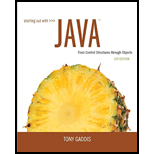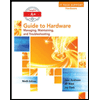
Starting Out with Java: From Control Structures through Objects (6th Edition)
6th Edition
ISBN: 9780133957051
Author: Tony Gaddis
Publisher: PEARSON
expand_more
expand_more
format_list_bulleted
Concept explainers
Expert Solution & Answer
Chapter 1.3, Problem 1.6CP
Explanation of Solution
Main memory:
Main memory or Random Access Memory (RAM) is the volatile memory which means the information stored in that memory would be erased when the computer is turned off.
- Main memory has a limited storage capacity so it cannot store a large amount of data.
- The data or information stored in the main memory is directly accessed by the Central Processing Unit (CPU).
Example:
Some of the examples of main memory are,
- RAM (Random Access Memory).
- ROM (Read Only Memory).
- EPROM (Erasable Programmable Read Only Memory).
- PROM (Programmable Read Only Memory).
- Cache memory.
- Registers.
Secondary storage:
- Secondary storage or secondary memory is the non-volatile memory which means the information stored in that memory cannot be erased even when there is any mishap in the computer...
Expert Solution & Answer
Want to see the full answer?
Check out a sample textbook solution
Students have asked these similar questions
Write the SQL code that permits to implement the tables: Student and Transcript. NB: Add the constraints on the attributes – keys and other.
Draw an ERD that will involve the entity types: Professor, Student, Department and Course. Be sure to add relationship types, key attributes, attributes and multiplicity on the ERD.
Draw an ERD that represents a book in a library system. Be sure to add relationship types, key attributes, attributes and multiplicity on the ERD.
Chapter 1 Solutions
Starting Out with Java: From Control Structures through Objects (6th Edition)
Ch. 1.3 - Why is the computer used by so many different...Ch. 1.3 - List the five major hardware components of a...Ch. 1.3 - Internally, the CPU consists of what two units?Ch. 1.3 - Prob. 1.4CPCh. 1.3 - Prob. 1.5CPCh. 1.3 - Prob. 1.6CPCh. 1.3 - What does the term multitasking mean?Ch. 1.5 - Describe the difference between a key word and a...Ch. 1.5 - Prob. 1.9CPCh. 1.5 - Describe the difference between a program line and...
Ch. 1.5 - Prob. 1.11CPCh. 1.5 - What happens to a variables current contents when...Ch. 1.5 - What is a compiler?Ch. 1.5 - Prob. 1.14CPCh. 1.5 - What is byte code?Ch. 1.5 - Prob. 1.16CPCh. 1.6 - What four items should you identify when defining...Ch. 1.6 - Prob. 1.18CPCh. 1.6 - What is pseudocode?Ch. 1.6 - Describe what a compiler does with a programs...Ch. 1.6 - Prob. 1.21CPCh. 1.6 - Is a syntax error (such as misspelling a key word)...Ch. 1.6 - What is the purpose of testing a program with...Ch. 1.7 - Prob. 1.24CPCh. 1.7 - Prob. 1.25CPCh. 1.7 - Prob. 1.26CPCh. 1.7 - Prob. 1.27CPCh. 1.7 - Prob. 1.28CPCh. 1 - Prob. 1MCCh. 1 - A byte is made up of eight a. CPUs b. addresses c....Ch. 1 - Each byte is assigned a unique a. address b. CPU...Ch. 1 - Prob. 4MCCh. 1 - Prob. 5MCCh. 1 - 6. This type of program is designed to be...Ch. 1 - These are words that have a special meaning in the...Ch. 1 - These are symbols or words that perform operations...Ch. 1 - These characters serve specific purposes, such as...Ch. 1 - These are words or names that are used to identify...Ch. 1 - Prob. 11MCCh. 1 - Prob. 12MCCh. 1 - Prob. 13MCCh. 1 - Prob. 14MCCh. 1 - The following pseudocode algorithm has an error....Ch. 1 - Available Credit A program that calculates a...Ch. 1 - Sales Tax A program that calculates the total of a...Ch. 1 - Account Balance A program that calculates the...Ch. 1 - The variable x starts with the value 0. The...Ch. 1 - The variable a starts with the value 10. The...Ch. 1 - Prob. 1SACh. 1 - Prob. 2SACh. 1 - What is the difference between operating system...Ch. 1 - Why must programs written in a high-level language...Ch. 1 - Why is it easier to write a program in a...Ch. 1 - What is a source file?Ch. 1 - Prob. 7SACh. 1 - What is an algorithm?Ch. 1 - What is a compiler?Ch. 1 - Prob. 10SACh. 1 - Prob. 11SACh. 1 - What must a computer have in order for it to...Ch. 1 - What is the difference between machine language...Ch. 1 - Why does byte code make Java a portable language?Ch. 1 - Prob. 15SACh. 1 - Prob. 16SACh. 1 - What part of an object forms an interface through...Ch. 1 - What type of program do you use to write Java...Ch. 1 - Will the Java compiler translate a source file...Ch. 1 - What does the Java compiler translate Java source...Ch. 1 - Prob. 21SACh. 1 - Prob. 22SACh. 1 - Your First Java Program This assignment will help...
Knowledge Booster
Learn more about
Need a deep-dive on the concept behind this application? Look no further. Learn more about this topic, computer-science and related others by exploring similar questions and additional content below.Similar questions
- 2:21 m Ο 21% AlmaNet WE ARE HIRING Experienced Freshers Salesforce Platform Developer APPLY NOW SEND YOUR CV: Email: hr.almanet@gmail.com Contact: +91 6264643660 Visit: www.almanet.in Locations: India, USA, UK, Vietnam (Remote & Hybrid Options Available)arrow_forwardProvide a detailed explanation of the architecture on the diagramarrow_forwardhello please explain the architecture in the diagram below. thanks youarrow_forward
- Complete the JavaScript function addPixels () to calculate the sum of pixelAmount and the given element's cssProperty value, and return the new "px" value. Ex: If helloElem's width is 150px, then calling addPixels (hello Elem, "width", 50) should return 150px + 50px = "200px". SHOW EXPECTED HTML JavaScript 1 function addPixels (element, cssProperty, pixelAmount) { 2 3 /* Your solution goes here *1 4 } 5 6 const helloElem = document.querySelector("# helloMessage"); 7 const newVal = addPixels (helloElem, "width", 50); 8 helloElem.style.setProperty("width", newVal); [arrow_forwardSolve in MATLABarrow_forwardHello please look at the attached picture. I need an detailed explanation of the architecturearrow_forward
- Information Security Risk and Vulnerability Assessment 1- Which TCP/IP protocol is used to convert the IP address to the Mac address? Explain 2-What popular switch feature allows you to create communication boundaries between systems connected to the switch3- what types of vulnerability directly related to the programmer of the software?4- Who ensures the entity implements appropriate security controls to protect an asset? Please do not use AI and add refrencearrow_forwardFind the voltage V0 across the 4K resistor using the mesh method or nodal analysis. Note: I have already simulated it and the value it should give is -1.714Varrow_forwardResolver por superposicionarrow_forward
- Describe three (3) Multiplexing techniques common for fiber optic linksarrow_forwardCould you help me to know features of the following concepts: - commercial CA - memory integrity - WMI filterarrow_forwardBriefly describe the issues involved in using ATM technology in Local Area Networksarrow_forward
arrow_back_ios
SEE MORE QUESTIONS
arrow_forward_ios
Recommended textbooks for you
 Enhanced Discovering Computers 2017 (Shelly Cashm...Computer ScienceISBN:9781305657458Author:Misty E. Vermaat, Susan L. Sebok, Steven M. Freund, Mark Frydenberg, Jennifer T. CampbellPublisher:Cengage Learning
Enhanced Discovering Computers 2017 (Shelly Cashm...Computer ScienceISBN:9781305657458Author:Misty E. Vermaat, Susan L. Sebok, Steven M. Freund, Mark Frydenberg, Jennifer T. CampbellPublisher:Cengage Learning Principles of Information Systems (MindTap Course...Computer ScienceISBN:9781285867168Author:Ralph Stair, George ReynoldsPublisher:Cengage Learning
Principles of Information Systems (MindTap Course...Computer ScienceISBN:9781285867168Author:Ralph Stair, George ReynoldsPublisher:Cengage Learning A+ Guide to Hardware (Standalone Book) (MindTap C...Computer ScienceISBN:9781305266452Author:Jean AndrewsPublisher:Cengage Learning
A+ Guide to Hardware (Standalone Book) (MindTap C...Computer ScienceISBN:9781305266452Author:Jean AndrewsPublisher:Cengage Learning Principles of Information Systems (MindTap Course...Computer ScienceISBN:9781305971776Author:Ralph Stair, George ReynoldsPublisher:Cengage Learning
Principles of Information Systems (MindTap Course...Computer ScienceISBN:9781305971776Author:Ralph Stair, George ReynoldsPublisher:Cengage Learning Systems ArchitectureComputer ScienceISBN:9781305080195Author:Stephen D. BurdPublisher:Cengage Learning
Systems ArchitectureComputer ScienceISBN:9781305080195Author:Stephen D. BurdPublisher:Cengage Learning Fundamentals of Information SystemsComputer ScienceISBN:9781337097536Author:Ralph Stair, George ReynoldsPublisher:Cengage Learning
Fundamentals of Information SystemsComputer ScienceISBN:9781337097536Author:Ralph Stair, George ReynoldsPublisher:Cengage Learning

Enhanced Discovering Computers 2017 (Shelly Cashm...
Computer Science
ISBN:9781305657458
Author:Misty E. Vermaat, Susan L. Sebok, Steven M. Freund, Mark Frydenberg, Jennifer T. Campbell
Publisher:Cengage Learning

Principles of Information Systems (MindTap Course...
Computer Science
ISBN:9781285867168
Author:Ralph Stair, George Reynolds
Publisher:Cengage Learning

A+ Guide to Hardware (Standalone Book) (MindTap C...
Computer Science
ISBN:9781305266452
Author:Jean Andrews
Publisher:Cengage Learning

Principles of Information Systems (MindTap Course...
Computer Science
ISBN:9781305971776
Author:Ralph Stair, George Reynolds
Publisher:Cengage Learning

Systems Architecture
Computer Science
ISBN:9781305080195
Author:Stephen D. Burd
Publisher:Cengage Learning

Fundamentals of Information Systems
Computer Science
ISBN:9781337097536
Author:Ralph Stair, George Reynolds
Publisher:Cengage Learning